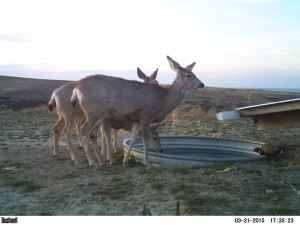
After participating in a conservation program for seven years that focuses on enhancing wildlife habitat, Nebraska farmer Leon “Bud” Gillespie, has created more wildlife habitat and resources while limiting erosion on his land. Pictured from left to right: Leon “Bud” Gillespie and Larry Steinbrecher, Morrill County FSA Executive Director.
Lifelong farmer, Leon “Bud” Gillespie, knows the importance of caring for the land to ensure it remains healthy and productive for future generations. He has seen firsthand how cropping environmentally sensitive land can affect the soil and environment in Morrill County, Nebraska.
“As land in this area was being settled in the late 1800s and early 1900s anything that looked like it could be farmed was broken out and planted to crops,” said Gillespie. “It was soon evident that much of this land should have been left as native grassland. The shallow soils and uneven terrain did not produce well and were subject to wind and water erosion.”
Gillespie says several areas of his land show evidence of once being farmed. Many of his acres were planted back to grass cover. Over time, much of the land was returned to native species. His farm today includes around 100 acres of cropland. However, it’s mostly native grassland pasture, hills, trees and rock outcroppings.
Gillespie has used no-till farming practices for 10 years as a way to conserve the farm’s silt loam and sandy silt loam soils located near the county’s southern border.
In 2008, Gillespie learned about the USDA Farm Service Agency (FSA) State Acres for Wildlife Enhancement (SAFE) initiative that helps restore vital habitat in order to meet high-priority state wildlife conservation goals. SAFE is an offshoot of USDA’s Conservation Reserve Program (CRP), which is celebrating its 30th anniversary in 2015. CRP is among the largest private lands programs for conservation used extensively throughout the United States to reduce soil erosion, improve water and air quality and provide wildlife habitat.
It’s a voluntary program that allows eligible landowners to receive annual rental payments and cost-share assistance to establish long-term, resource-conserving covers on eligible farmland throughout the duration of their 10-to-15-year contracts.
Through SAFE, landowners re-establish wetlands, grasses and trees on their land. These practices are designed to increase important wildlife populations by creating critical habitat and food sources.
Gillespie used SAFE to set aside land for pheasants and other wildlife. He planted the land with a large variety of grasses, forbs and various shrub plots. He also built guzzlers, which are self-filling water facilities that collect, store and provide water for wildlife. By 2011, Gillespie enrolled 110 acres into the program.
“The land we selected for the program was primarily classified as highly erodible and the prospect of producing a good crop was very much subject to the levels of moisture, wind and hail we received each year,” said Gillespie.
According to Gillespie, the SAFE program has been a good fit for his operation and he is considering adding more acres.
“I am very pleased with our success in providing a good habitat for pheasants, deer, grouse and elk,” said Gillespie. “At the same time, the land is gaining in organic matter and not suffering from erosion.”
Gillespie appreciates the assistance he received from Pheasants Forever throughout the entire process. A Pheasants Forever biologist developed a plan adapted for the area that provides suitable habitat for pheasants and other wildlife. Gillespie also worked in cooperation with the Nebraska Department of Natural Resources to help offset some of the costs for seed and use of a seeding drill to establish the habitat.
Since being established on December 23, 1985, CRP has helped prevent more than 8 billion tons of soil from eroding and protected more than 170,000 stream miles with riparian and grass buffers, more than 100,000 acres of bottomland hardwood trees, nearly 300,000 acres of flood-plain wetlands, and 250,000 acres each for duck nesting habitat and upland bird habitat.
2015 marks the 30th Anniversary of CRP. For an interactive tour of CRP success stories from across the U.S., please visit the FSA CRP 30th Anniversary website at http://www.fsa.usda.gov/CRPis30.







2 Responses to No-till Farming, Wildlife Conservation, Ideal in Nebraska